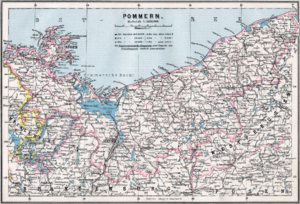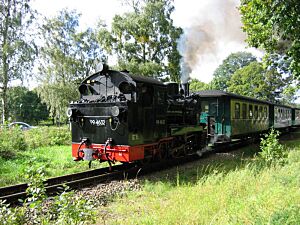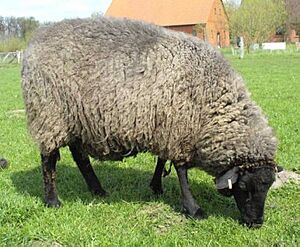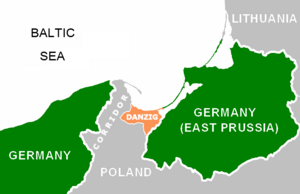History of Pomerania (1806–1933) facts for kids
The name Pomerania comes from a Slavic phrase, po more, which means "land by the sea." This article tells the story of Pomerania from the early 1800s until the 1930s.
From the time of the Napoleonic Wars until the end of World War I, Pomerania was part of Prussia. It was known as the Province of Pomerania, which included Western and Farther Pomerania, and the Province of West Prussia (also called Pomerelia). After World War I, Pomerania was split between Poland and Germany.
After Kaiser Wilhelm II stepped down as Emperor of Germany and King of Prussia, Western Pomerania became part of the Free State of Prussia within the Weimar Republic (Germany's government after WWI). The eastern part, Pomerelia, became part of Poland and was called the Pomeranian Voivodeship. A new area called the Polish Corridor was created from most of West Prussia. This caused many Germans living there to move away. Poland then built a big port city on the Baltic Sea called Gdynia. The area around Danzig became its own city-state, the Free City of Danzig.
The industrial revolution mostly changed the Stettin area and its transportation. However, most of Pomerania stayed a rural area, focused on farming. After 1850, many German Pomeranians moved away, mostly to Berlin, industrial areas in western Germany, or even overseas. Many also moved to the United States, especially to Wisconsin.
Contents
Napoleonic Wars and Changes
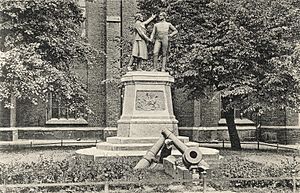
In late 1806, Prussia lost the Battle of Jena-Auerstedt. French troops then marched into the Pomeranian province. The strong city of Stettin surrendered without a fight, and the French took over the province. Only the city of Kolberg resisted. The French started a siege in March 1807. Ferdinand von Schill was one of the defenders. The siege failed and was lifted when Prussia surrendered to Napoleon Bonaparte in the Peace of Tilsit on July 2.
Napoleon's control also stopped Gustav IV Adolf of Sweden's plans to build a strong port city called Gustavia on Rügen. Construction started in 1806, but the French destroyed the unfinished town the next year.
Prussia had to pay a lot of money (25 million Taler from Pomerania alone) as war reparations. The French troops were supposed to leave, but they kept delaying. In November 1808, French troops left most of the province, but they stayed in Stettin. This forced the local government to move to Stargard in 1809.
In 1812, French troops invaded Swedish Pomerania and also took over Prussian Pomerania again. Prussian troops gathered in Kolberg. After Ludwig Yorck von Wartenburg, a Prussian commander, left the alliance with France in December 1812, the Prussian military called Pomeranians to fight in February 1813. Also in February, Russian troops reached Farther Pomerania. By March, all French forces left Pomerania, except for Stettin, which they held until December 5, 1813.
After the war, Prussia gained Swedish Pomerania through diplomatic efforts by Karl August von Hardenberg at the Congress of Vienna. Prussia paid money to Denmark and Sweden for it. On October 23, 1815, Swedish Pomerania joined the Prussian province, forming the new Province of Pomerania.
After Napoleon broke up the Holy Roman Empire in 1806, the western part of Pomerania joined the German Confederation. When the German Empire was founded in 1871, all of Pomerania became part of this new country.
Pomeranian Provinces (1815-1914)
Province of Pomerania before World War I
The Province of Pomerania was a province of the Kingdom of Prussia and later the Free State of Prussia from 1815 until 1934.
How the Province Was Created
Even though there was an older Prussian Province of Pomerania, the new Province of Pomerania was created in 1815. This happened because of a new law about provincial offices and the addition of Swedish Pomerania.
The new law changed all Prussian areas, creating ten (later eight) provinces with similar ways of being governed. The new Province of Pomerania included the old province and Swedish Pomerania, plus some other areas.
The province was led by a governor called an Oberpräsident, who lived in the capital city, Stettin. The province was divided into smaller areas called Regierungsbezirke, each led by a president. At first, there were two regions planned: Stettin (for Western Pomerania) and Köslin (for Farther Pomerania). However, because of promises made when Swedish Pomerania joined, a third region, Regierungsbezirk Stralsund, was created for the former Swedish Pomerania.
In 1818, the governor Johann August Sack reorganized the county (Kreis) borders. The Köslin region had nine counties, Stettin had thirteen, and Stralsund had four.
The new parliament (Landtag) met for the first time on October 3, 1824. It had 25 lords and knights, 16 representatives from towns, and eight from rural communities.
The province was always a strong area for conservative political parties.
Transportation and Modernization
In the 1800s, the first main roads and railways were built in Pomerania. By 1848, over 126 Prussian miles of new roads were finished. The railway from Berlin to Stettin started construction in 1840 and was completed in 1843. Other railways followed, connecting Stettin to Köslin (1859), Angermünde to Stralsund (1863), and Stettin to Stolp (1869). A connection to Danzig was made in 1870.
In farming areas, many narrow-gauge railways were built to transport crops faster. Towns also got their first gas, water, and power plants. Streets and sewer systems in towns were updated.
Building narrow-gauge railways was encouraged by a special law in 1892, which provided financial help. By 1900, there were over 1,000 kilometers of these railways.
From 1910 to 1912, most of the province received electricity as main power lines were built. Power plants had been built since 1898.
The Swine and lower Oder rivers, which were important for shipping to Stettin, were made deeper (5 meters) and shorter by a canal (Kaiserfahrt) in 1862. Heavy industries grew in Stettin, making it the only industrial center in the province.
Stettin was connected to Berlin by the Berlin-Stettin waterway in 1914. Other traditional waterways and ports in the province became less important. Exceptions were the port of Swinemünde, used by the navy, the port of Stolpmünde, which shipped some goods from Farther Pomerania, and the port of Sassnitz, built in 1895 for railway ferries to Scandinavia.
With better transportation, many tourists started visiting the Baltic coast. The tourist town of Binz had 80 visitors in 1870, 10,000 in 1900, and 22,000 in 1910. Other tourist towns saw similar growth.
Farming Changes
In 1807, Prussia passed a law ending serfdom, which meant farmers were no longer tied to the land. Another law in 1811 set the rules for how serfs could become free. They could pay money or give part of their land to their former lord. These changes happened in the early years of the province. By 1838, over 10,000 peasants were freed by paying money or giving up land.
In 1847, there were protests in Stettin and Köslin because of food shortages. As a result, prices for some foods were set.
On March 2, 1850, a law was passed that allowed peasants and farmers to buy their land rights and end their feudal duties. This meant they could get a long-term loan (41 to 56 years to pay back). This law led to the creation of "Rentenbank" credit banks and "Rentengut" farms. Farmers who used these loans to become free now had control over their land. Before, how land was used was decided by social status, not ownership.
From 1891 to 1910, 4,731 "Rentengut" farms were created. Most of these were 10 to 25 hectares in size.
Bismarck's Reforms
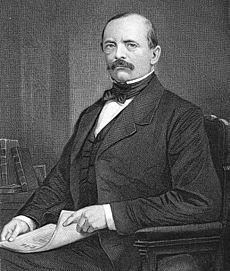
Otto von Bismarck, a famous German leader, owned land in Farther Pomerania. He even studied farming in Greifswald. From 1867 to 1874, he bought and expanded his Varzin estates.
In 1869, a county reform was proposed by Friedrich Albrecht Graf zu Eulenburg and supported by Bismarck. This reform passed in 1872. The most important change was that voting rights no longer depended on being a noble. Instead, they depended on how much property someone owned (if they paid above a certain amount in taxes). This was to give more power to middle-class citizens compared to the nobles.
In 1875, a new constitution for the province was passed, which started in 1876. It clarified the duties of the provincial government (led by the Oberpräsident) and the self-governing bodies (like the provincial parliament, Provinziallandtag). The Provinzialverband (the group of self-governing institutions) was funded by the Prussian state. The parliament was in charge of roads, welfare, education, and culture. Owning land was no longer a requirement to be elected. The provincial parliament was elected directly by county and town representatives for a six-year term.
In 1891, another county reform allowed more local self-government. Towns and villages could now elect their own leaders and local parliaments.
Border Changes from Versailles Treaty
Compared to other provinces, the Peace Treaty of Versailles in 1919 had little effect on the size of the Province of Pomerania. Some small parts of the eastern rural areas, totaling about 9.64 square kilometers with 224 people in 1910, were given to Poland.
How the Province Was Divided
Until 1932, the province was divided into three government regions: Köslin (eastern part, Farther Pomerania), Stettin (southwestern part, Old Western Pomerania), and Stralsund (northwestern part, New Western Pomerania). In 1932, the Stralsund region was combined with the Stettin region. The provincial capital was Stettin (now Szczecin). The capitals of the regions were Köslin (now Koszalin), Stettin, and Stralsund.
People of Province of Pomerania
Population Numbers
- 1905: 1,684,326 people (56 people per square kilometer). Most were Protestants (1,616,550), with 50,206 Catholics and 9,660 Jews.
- 1925: 1,878,780 people.
Languages Spoken
- 1900: Most people spoke German. Near the border with the Province of West Prussia, there were 14,162 people who spoke Polish. Near the Leba Lake and Garde Lake, 310 people spoke Kashubian.
Province of West Prussia
From 1807 to 1813, during the Napoleonic Wars, southern parts of West Prussia were added to the Duchy of Warsaw, a state controlled by Napoleon. In 1815, the province was returned to Prussia. It was divided into two regions: Danzig and Marienwerder. From 1829 to 1878, West Prussia was combined with East Prussia to form the Province of Prussia. After that, they became separate provinces again. The region became part of the German Empire in 1871 when Germany united.
Population in West Prussia
| Ethnic Groups in West Prussia | ||||
|---|---|---|---|---|
| Year | 1858 | 1890 | 1905 | 1910 |
| Total Population | ? | 1,433,681 | 1,641,936 | ? |
| % Poles (including Kashubians) |
30.9% | 33.8% | 34.4% | ~35% |
| % Germans * including bilinguals |
69.1% | 66.2%* | 65.6%* | ~65% |
- 1875: 1,343,057 people
- 1880: 1,405,898 people
- 1890: 1,433,681 people (717,532 Catholics, 681,195 Protestants, 21,750 Jews, others)
- 1900: 1,563,658 people (800,395 Catholics, 730,685 Protestants, 18,226 Jews, others)
- 1905: 1,641,936 people (including 437,916 Poles, 99,357 Kashubians)
World War I and What Came Next
After World War I, the Treaty of Versailles (1919) divided Pomerania between Poland and Germany. Most of the German-Prussian province of West Prussia went to Poland. This area was called the Polish Corridor. It became the Pomeranian Voivodeship in Poland, with its capital at Toruń. The remaining western parts of West Prussia joined Posen-West Prussia in 1922. The eastern parts became part of Regierungsbezirk West Prussia within East Prussia. The Danzig area became the Free City of Danzig.
The Polish Corridor
The "Polish Corridor" was created to give the newly re-established Polish state access to the Baltic Sea. It was made from 70% of the old province of West Prussia, including areas of Pomerelia and Chelmno (Kulmer) Land. This corridor cut Germany off from its province of East Prussia. In Poland, the corridor mostly formed the Pomeranian Voivodeship.
After seaport workers in the Free City of Danzig went on strike during the Polish-Soviet War, the Polish government decided to build a new seaport at Gdynia within the Corridor. Many Germans living in the Polish Corridor left the area after it was given to Poland in June 1919. Poland took full control on January 20, 1920. People who wanted to stay had to become Polish citizens, as Poland did not allow German citizens to live in its territory. Former German public officials were not accepted as Polish citizens and had to leave. Others who refused to give up German citizenship also had to leave. Because fewer Germans lived there, German schools closed, and property of former German residents was taken over.
Polish authorities sometimes tried to stop traffic through the Corridor, affecting mail, telegraph, and phone services. A British representative noted in March 1920 that the bad feelings between Poles and Germans were growing. He believed the new borders would not last.
Because of these problems, the German Ministry for Transport started the Seedienst Ostpreußen ("Sea Service East Prussia") in 1922. This provided a ferry connection to the German area of East Prussia, so people didn't have to travel through Polish territory.
Land Reform
In 1925, the Polish government started a land reform program. This aimed to take land from large landowners and give it to small farmers. German landowners usually owned the biggest pieces of land, so they were affected first. A Polish official, Wiktor Lamot, said that the part of Pomerania with the Corridor "must be cleansed of larger German holdings." German landowners who stayed in Polish Pomerania felt angry about losing their status and special position. This made them more nationalistic and anti-Polish.
People Living There
Most of the area was home to Poles, Germans, and Kashubians. From 1886, Prussia had a Settlement Commission to encourage Germans to move there. At the same time, Germans were moving west during the Ostflucht (flight from the East). In 1910, 42.5% of the population was German (421,029 Germans), including soldiers and officials. By 1921, Germans made up 18.8% (175,771). Over the next ten years, the German population dropped by another 70,000, making their share 9.6%. There was also a Jewish minority. In 1905, about 72,500 Kashubians lived there.
Germans Leaving the Area
The Versailles Treaty said that Germans in the land given to Poland (the Polish Corridor) had until 1922 to choose Polish or German citizenship.
However, many were forced to decide right away: either for Germany (and be expelled) or for Poland (and join the Polish army).
Also, many Germans who were public officials, workers with no ties to the area, or military personnel left.
Free City of Danzig
The Free City of Danzig included the main city of Danzig (Gdańsk), as well as Zoppot (Sopot), Tiegenhof (Nowy Dwór Gdański), Neuteich (Nowy Staw), and about 252 villages and 63 small settlements. The total area was about 1,966 square kilometers.
Polish Rights in Danzig
Poland was supposed to represent the Free City in other countries. Danzig also had to be in a customs union with Poland. The German railway line connecting the Free City with Poland was to be managed by Poland. Also, the Westerplatte (which was a city beach) was given to Poland, which built a military post in the city's harbor. A separate Polish post office was also set up next to the city's own post office.
League of Nations' Role
Danzig was under the authority of the League of Nations itself, not given to a single country. Representatives from different countries served as High Commissioner.
Population of Danzig
The Free City had a population of 357,000 in 1919. About 95% of them spoke German. The rest mainly spoke Kashubian or Polish.
The Treaty of Versailles separated Danzig and its villages from Germany. It required the new state to have its own citizenship, based on living there. German residents lost their German nationality when the Free City was created. However, they had two years to get it back. If they did, they had to leave their property and move outside the Free City of Danzig area, into the remaining part of Germany.
It quickly became clear that most German people in the Free State were unhappy about the agreements made with Poland and being separated from Germany. By 1939, Professor Burckhardt, the League of Nations' High Commissioner in Danzig, found it almost impossible to settle the many ongoing disagreements.
Province of Pomerania (After WWI)
No battles took place in the province during World War I.
However, the war affected society, the economy, and how the province was run. During the war, the provincial government was controlled by the military. Many men were drafted into the army, causing a shortage of workers in farming, construction, and other industries not related to the war. Women, young people, and prisoners of war partly filled these roles. Imports and fishing decreased when ports were blocked. As the war continued, there were food shortages, especially in the winter of 1916/17. Sometimes, coal, gas, and electricity were also unavailable.
When the Treaty of Versailles started on January 10, 1920, the province's eastern border became the border with the new Second Polish Republic. This new country included most of Pomerelia in the Polish Corridor. There were minor border changes: 9.5 square kilometers of the province became Polish, and 74 square kilometers of former West Prussia joined the province.
Province of the Free State of Prussia
After the Kaiser was forced to step down, the province became part of the Free State of Prussia within the Weimar Republic (Germany's new government).
German Revolution (1918–1919)
During the German Revolution of 1918–1919, revolutionary councils of soldiers and workers took control of Pomeranian towns. This happened in Stralsund on November 9, and in Stettin, Greifswald, Pasewalk, Stargard, and Swinemünde on November 10. By January 5, 1919, workers' and soldiers' councils were in charge of most of the province. The revolution was peaceful, with no reports of riots. The councils were led by Social Democrats, who worked with the provincial government.
On November 12, 1918, a law was passed allowing farmworkers' unions to talk with farmers. This law also set rules for work hours and wages for farmworkers.
On May 15, 1919, street fights and looting happened in Stettin after Communist meetings. The military stopped the revolt. In late August, farmworkers went on strike in the counties of Neustettin and Belgard. However, the power of the councils decreased, and only a few remained in larger towns by 1920.
Counter-Revolution
Conservative and right-wing groups formed to oppose the revolution's changes. Landowners created the Pommerscher Landbund in February 1919. By 1921, it had 120,000 members and was given weapons by the army. Paramilitary groups called "Einwohnerwehr" also formed in the spring of 1919.
Units from the Pommerscher Landbund took part in the nationalist Kapp Putsch in Berlin in 1920.
Members of the "Iron Division," a disbanded Freikorps in the Baltic (volunteer military unit), reorganized in Pomerania. Landowners hosted them on their estates as a private army.
Some counter-revolutionary Pomeranians also formed Freikorps and fought in the Ruhr area.
Constitution of 1920
In 1920, the Free State of Prussia adopted a democratic constitution for its provinces. This constitution gave many civil rights to the Prussian people and improved the self-government of the provinces.
The provincial and county parliaments (Landtag and Kreistag) were now elected directly by the people, including women, in free and secret votes.
The "Provinzialverband," which included all self-governing bodies of the province, gained more power over the provincial government, which used to be controlled by Berlin. The Provinzialverband would now elect the Oberpräsident (head of administration) and appoint representatives for the Reichsrat assembly in Berlin. Also, Provinzialverband officials could now decide how to spend the money they received from Berlin.
Economy
The border changes after the war caused a big decline in the province's economy. Farther Pomerania was cut off from Danzig by the corridor. Old markets and supplies in the now Polish areas were no longer available.
Farmers in Farther Pomerania used to sell their products mostly to the eastern provinces, which were now part of Poland. Because of high transport costs, markets in the West were also hard to reach. Farmers tried to modernize their equipment, improve their products, and use new farming methods. As a result, more than half of the farmers were deeply in debt by 1927. The government helped with the Osthilfe program, giving loans with good conditions.
Stettin especially suffered from changes in trade routes after the war. Before, it was a key route for exports from the Kattowitz industrial region in now Polish Upper Silesia. Poland changed this export route to a new railway connecting Kattowitz with the new port of Gdingen within the corridor.
To counter this, Prussia invested in the Stettin port starting in 1923. While this helped at first, a new economic downturn led to the closure of one of Stettin's major shipyards, Vulcan-Werft, in 1927.
The province also adapted to new types of transportation. Roads were improved for cars and buses. Four towns got electric streetcars, and an international airport was built in Altdamm near Stettin.
Pomeranian agriculture faced a crisis. Programs were started to reclaim land that had become swamps during the war, and even to create new settlements. The results were mixed. On one hand, 130,858 hectares of farmland were settled with 8,734 new farms by 1933. The settlers came from Pomerania itself, Saxony, Thuringia, and also refugees from the former Province of Posen. On the other hand, many people left rural communities and moved to Pomeranian and other cities (a trend called Landflucht). In 1925, 50.7% of Pomeranians worked in farming, but this dropped to 38.2% by 1933.
With the economic downturn, unemployment reached 12% in 1933, compared to 19% in the whole country.
Images for kids


